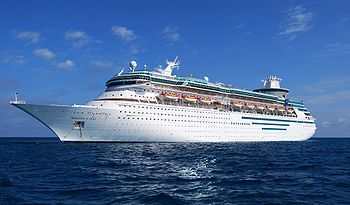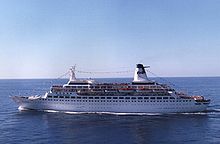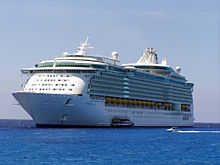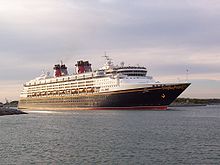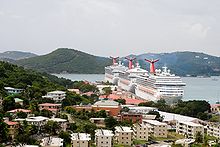- Cruise ship
-
A cruise ship or cruise liner is a passenger ship used for pleasure voyages, where the voyage itself and the ship's amenities are part of the experience, as well as the different destinations along the way. Transportation is not the prime purpose, as cruise ships operate mostly on routes that return passengers to their originating port, so the ports of call are usually in a specified region of a continent.
In contrast, dedicated transport oriented ocean liners do "line voyages" and typically transport passengers from one point to another, rather than on round trips. Traditionally, an ocean liner for the transoceanic trade will be built to a higher standard than a typical cruise ship, including high freeboard and stronger plating to withstand rough seas and adverse conditions encountered in the open ocean, such as the North Atlantic. Ocean liners also usually have larger capacities for fuel, victuals, and other stores for consumption on long voyages, compared to dedicated cruise ships.
Although often luxurious, ocean liners had characteristics that made them unsuitable for cruising, such as high fuel consumption, deep draught that prevented them from entering shallow ports, enclosed weatherproof decks that were not appropriate for tropical weather, and cabins designed to maximize passenger numbers rather than comfort (few if any private verandas, a high proportion of windowless suites). The modern cruise ships, while sacrificing qualities of seaworthiness, have added amenities to cater to tourists, and recent vessels have been described as "balcony-laden floating condominiums".
The lines between ocean liners and cruise ships have blurred, particularly with respect to deployment, although the differences in construction remain. Larger cruise ships have also engaged in longer trips such as transocean voyages which may not lead back to the same port for months (longer round trips).[1] Some former ocean liners operate as cruise ships, such as MS Marco Polo and MS Mona Lisa, however this number is ever decreasing. The only dedicated transatlantic ocean liner in operation as a liner, as of February 2010, is the Queen Mary 2 of the Cunard fleet, however she also has the amenities of contemporary cruise ships and sees significant service on cruises.[2]
Cruising has become a major part of the tourism industry, accounting for U.S.$29.4 billion with over 19 million passengers carried worldwide[3] in 2011. The industry's rapid growth has seen nine or more newly built ships catering to a North American clientele added every year since 2001, as well as others servicing European clientele. Smaller markets, such as the Asia-Pacific region, are generally serviced by older ships. These are displaced by new ships in the high growth areas.
The world's largest cruise ships are Royal Caribbean International's MS Oasis of the Seas and its sister ship MS Allure of the Seas.
Contents
History
Early years
The first vessel built exclusively for this purpose was the Prinzessin Victoria Luise, designed by Albert Ballin, general manager of Hamburg-America Line. The ship was completed in 1900.
The practice of cruising grew gradually out of the tradition of transatlantic crossings, which never took fewer than four days. In the competition for passengers, ocean liners added luxuries — the Titanic being the most famous example — such as fine dining and well-appointed staterooms.
In the late 19th century, Albert Ballin, director of the Hamburg-America Line, was the first to send his transatlantic ships out on long southern cruises during the worst of the winter season of the North Atlantic. Other companies followed suit. Some of them built specialized ships designed for easy transformation between summer crossings and winter cruising.
Jet age impact on Cruising
With the advent of large passenger jet aircraft in the 1960s, intercontinental travelers largely switched from ships to planes, sending the ocean liner trade into a slow decline. Certain characteristics of older ocean liners made them unsuitable for cruising duties, such as high fuel consumption, deep draught preventing them from entering shallow ports, and cabins (often windowless) designed to maximize passenger numbers rather than comfort. Ocean liner services aimed at passengers ceased in 1986, with the notable exception of transatlantic crossings operated by the Cunard Line, catering to the niche market who appreciated the several days at sea away from civilization.
In comparison to liner crossings, cruising voyages gained popularity; slowly at first but at an increased rate from the 1980s onwards. Initially the fledgling industry was serviced primarily by small redundant liners, and even the first purpose built cruise ships were small. This changed after the success of the SS Norway (originally the ocean liner SS France, which was converted to cruising duties) as the Caribbean's first "super-ship".
Contemporary cruise ships built in the late 1980s and beyond, such as Sovereign-class which broke the size record held for decades by Norway, show characteristics of size and strength once reserved for ocean liners—some have undertaken regular scheduled transatlantic crossings.[1] The Sovereigns were the first modern "megaships" to be built, they also were the first series of cruise ships to include a multi-story atrium with glass elevators. They also had a single deck devoted entirely to cabins with private balconies instead of oceanview cabins. Other cruise lines soon launched ships with similar attributes, such as the Fantasy class and Crown Princess. As the veranda suites were particularly lucrative for cruise lines, something which was lacking in older ocean liners, recent cruise ships have been designed to maximize such amenities and have been described as "balcony-laden floating condominiums".
There have been nine or more newly-built cruise ships added every year since 2001, all at 100,000 tonnes or greater. The only comparable ocean liner to be completed in recent years has been Cunard Line's Queen Mary 2 in 2004. Following the retirement of her running mate the Queen Elizabeth 2 in November 2008, Queen Mary 2 is the only liner operating on transatlantic routes, though she also sees significant service on cruise routes.[2]
Amenities
Until 1975-1980, cruises offered shuffleboard, deck chairs, "drinks with umbrellas and little else for a few hundred passengers." After 1980, they offered increasing amenities. As of 2010, city-sized ships have dozens of amenities.[4]
21st century
Luxury cruises are often centered around the Caribbean, Alaska, and Mexico. For certain destinations such as the Arctic and Antarctica, cruise ships are the most common way to visit. The largest passenger cruise ships are the Oasis class vessels owned and operated by Royal Caribbean International.[5][dead link]
Organization
Cruise ships are organized much like floating hotels, with a complete hospitality staff in addition to the usual ship's crew. It is not uncommon for the most luxurious ships to have more crew and staff than passengers.Dining
Dining on almost all cruise ships is included in the cruise price, except on no-frills lines such as EasyCruise.
Traditionally, the ships' restaurants organize two dinner services per day and passengers are allocated a set dining time for the entire cruise, but a recent trend is to allow diners to dine whenever they want. Cunard Line ships maintain the class tradition of ocean liners and have separate dining rooms for different types of suites, while Celebrity Cruises and Princess Cruises have a standard dining room and "upgrade" specialty restaurants that require pre-booking and cover charges.
Besides the dining room, modern cruise ships also usually feature one or more casual buffet-style eateries, often open 24 hours and with menus that vary throughout the day to provide meals ranging from breakfast to late-night snacks. Ships also feature numerous bars and nightclubs for passenger entertainment; the majority of cruise lines do not include alcoholic beverages in their fares and passengers are expected to pay for drinks as they consume them. Most cruise lines also prohibit passengers from bringing aboard and consuming their own alcohol (alcohol purchased duty-free is sealed and only returned to passengers when they disembark) while on-board the ship.
There is often a central galley responsible for serving all major restaurants aboard the ship, though specialty restaurants may have their own separate galleys.
As with any vessel, adequate provisioning is crucial, especially on a cruise ship serving several thousand meals at each seating. For example, passengers and crew on the Royal Caribbean International ship Mariner of the Seas consume 20,000 pounds (9,000 kg) of beef, 28,000 eggs, 8,000 gallons (30,000 L) of ice cream, and 18,000 slices of pizza in a week.[citation needed] Normally, a cruise ship stocks up at its home port, however they also have special arrangements with designated suppliers at ports of call if required.
Other on-board facilities
Most modern cruise ships feature the following facilities:
- Casino - Only open when the ship is at sea
- Spa
- Fitness center
- Shops - Only open when ship is at sea
- Library
- Theatre with Broadway style shows
- Cinema
- Indoor and/or outdoor swimming pool
- Hot tub
- Buffet restaurant
- Lounges
- Gym
- Clubs
Some ships have bowling alleys, ice skating rinks, rock climbing walls, miniature golf courses, video arcades, basketball courts, or tennis courts.
Crew
Crew are usually hired on four to six month contracts that are renewed frequently, based upon feedback from passengers. There are no paid vacations or pensions. Crew members do not have any expenses while onboard as food and accommodation are included, and this makes a cruise ship career financially attractive enough to compensate for lack of employment benefits.
Living arrangements vary by cruise line, but mostly by shipboard position. Senior officers are assigned single cabins. In general two employees share a cabin with a shower, commode and a television set. There are a set of facilities for the crew, separate from that of passengers, such as a fitness center, a crew recreation room (simply crew bar), mess hall, and a crew deck with a swimming pool.[6]
Ship naming
Older cruise ships have had multiple owners. Since each cruise line has its own livery and often a naming theme (for instance, ships of the Holland America Line have names ending in "-dam", e.g. MS Statendam, and Royal Caribbean's ships' names all end with "of the Seas", e.g. MS Freedom of the Seas, ships of Cunard Line have the title of "Queen", e.g. RMS Queen Mary 2), it is usual for the transfer of ownership to entail a refitting and a name change. Some ships have had a dozen or more identities.
Cruise ships utilization
Due to slower speed and reduced seaworthiness, as well as being largely introduced after several major wars, cruise ships have never been used as troop transport vessels. By contrast, ocean liners were often seen as the pride of their country and used to rival liners of other nations, and have been requisitioned during both World Wars to transport soldiers and serve as hospital ships.
Cruise ships and former liners often find employment in applications other than those for which they were built. A shortage of hotel accommodation for the 2004 Summer Olympics led to a plan to moor a number of cruise ships in Athens to provide tourist accommodation.
On September 1, 2005, the U.S. Federal Emergency Management Agency (FEMA) contracted three Carnival Cruise Lines vessels to house Hurricane Katrina evacuees.[7]
In response to the shutdown of UK airspace due to the eruption of Iceland's Eyjafjallajökull volcano, the newly completed Celebrity Eclipse was used to rescue 2000 British tourists stranded in Spain as "an act of goodwill" by the owners. The ship departed from Southampton for Bilbao on April 21, and returned on April 23.[8]
Regional industries
The number of cruise tourists worldwide in 2005 was estimated at some 14 million. The main region for cruising was North America (70% of cruises), where the Caribbean islands were the most popular destinations.
Next was Continental Europe (13%), where the fastest growing segment is cruises in the Baltic Sea.[9] The most visited Baltic ports are Copenhagen, St. Petersburg, Tallinn, Stockholm and Helsinki.[10] The seaport of St. Petersburg, the main Baltic port of call, received 426,500 passengers during the 2009 cruise season.[11]
According to 2010 CEMAR[12] statistics the Mediterranean cruise market is going through a fast and fundamental change; Italy has won prime position as a destination for European cruises, and destination for the whole of the Mediterranean basin. The most visited ports in Mediterranean Sea are Barcelona (Spain), Civitavecchia (Italy), Palma (Spain) and Venice (Italy).
Caribbean cruising industry
The Caribbean cruising industry is a large and growing market, and the most popular. Cruising has grown from "an estimated 900,850 passengers in 1983 to 2.3 million passengers in 1993".[13] Cruise lines operating in the Caribbean include Royal Caribbean International, Princess Cruises, Carnival Cruise Line, Celebrity Cruises, Disney Cruise Line, Holland America, P&O, Cunard, Crystal Cruises, and Norwegian Cruise Line. There are also smaller cruise lines that cater to a more intimate feeling among their guests. The three largest cruise operators are Carnival Corporation, Royal Caribbean International, and Star Cruises/Norwegian Cruise Lines.
Some of the American cruise lines in the Caribbean depart from ports in the United States, "nearly one-third of the cruises sailed out of Miami".[13] Other cruise ships depart from Port Everglades (in Fort Lauderdale), Port Canaveral (approximately 45 miles (72 km) east of Orlando), New York, Tampa, Galveston, New Orleans, Cape Liberty, Baltimore, Jacksonville, Charleston, Norfolk, Mobile, and San Juan, Puerto Rico. Some UK cruise lines base their ships out of Barbados for the Caribbean season, operating direct charter flights out of the UK and avoiding the sometimes lengthy delays at US immigration.
Cruises sailing in the Caribbean travel on itineraries depending on the port of departure and the length of the cruise. The busiest port of call is The Bahamas with "1.8 million cruise-ship arrivals in 1994".[13] This is because its short distance from Florida is very convenient for both short and long cruises. The next most popular ports of call were "the US Virgin Islands (1.2 million), St. Maarten (718,553), Puerto Rico (680,195), the Cayman Islands (599,387), and Jamaica (595,036)".[13] Other ports of call include: Belize City, Costa Maya, Cozumel, Antigua, Aruba, Grand Turk, Honduras and Key West. It is also worthy to note that these figures are from 1994 and highly outdated, so although the same ports are at the forefront today, the figures are very different. St. Thomas in the US Virgin Islands is particularly popular with US passengers because they get a second duty-free allowance to use on goods purchased there.
Shipyards
The construction market for cruise ships is dominated by three European companies and one Asian company:
- STX Europe of Norway with two shipyards:
- STX Europe (the former Aker Yards/Kvaerner Masa-Yards/Wärtsilä, Valmet and Rauma Shipyards) in Finland.
- Aker Yards France (Chantiers de l'Atlantique) in France.
- Fincantieri of Italy.
- Meyer Werft of Germany.
- Mitsubishi Heavy Industries of Japan.
A large number of cruise ships have been built by other shipyards, but no other individual yard has reached the large numbers of built ships achieved by the four above. A handful of old ocean liners also remain in service as cruise ships. Despite the dominance of United States-based cruise ship operators and American clients in the industry, only one ship built in the United States, The Emerald, is still sailing.[citation needed]
Infections on cruise ships
Norovirus
Norovirus is the most common cause of gastroenteritis in developed countries and is so widespread that only the common cold is reported more frequently.[14] Symptoms usually last between 1 and 3 days and generally resolve without treatment or long term consequences. The incubation period of the virus averages about 24 hours.[15]
The estimated likelihood of contracting gastroenteritis from any cause on an average 7-day cruise is less than 1%.[16] In 2009, during which more than 13 million people took a cruise,[17] there were nine reported norovirus outbreaks on cruise ships.[18] Outbreak investigations by the U.S. Centers for Disease Control and Prevention have shown that transmission among cruise ship passengers is primarily person-to-person; potable water supplies have not been implicated. In 2009, ships undergoing unannounced inspections in U.S. ports received an average CDC Vessel Sanitation Program score of approximately 97 out of a total possible 100 points.[19] The minimum passing inspection score is 85.[19] Collaboration with the CDC’s Vessel Sanitation Program and the development of Outbreak Prevention and Response Plans have helped to generally decrease the incidence of norovirus outbreaks on ships.[20]
Legionnaires' disease
Other pathogens which can colonise pools and spas including those on cruise ships include Legionella, the bacteriium which causes Legionnaires' disease. Legionella, and in particular the most virulent strain, Legionella pneumophila serogroup 1, can cause infections when inhaled as an aerosol or aspirated. Individuals who are immunocompromised and those with pre-existing chronic respiratory and cardiac disease are more susceptible. Legionnaires' has been infrequently associated with cruise ships.[21][22][23] The Cruise industry Vessel Sanitation Program has specific public health requirements to control and prevent Legionella.[24]
Security
There have been several high profile incidents on cruise ships, including pirate attacks on Seabourn Spirit and MSC Melody.[25][26] As a result, cruise ships have implemented various security measures including LRADs to deter pirates, as well as CCTV, metal detectors and x-rays to prevent weapons and contraband onboard.[27]
In addition to these measures, passengers are often given a personal identification card, which must be shown in order to get on or off the ship. This prevents people boarding who are not entitled to do so, and also ensures the ship's crew are aware of who is on the ship.[28]
Environmental impact
- "Cruise ships generate a number of waste streams that can result in discharges to the marine environment, including sewage, graywater, hazardous wastes, oily bilge water, ballast water, and solid waste. They also emit air pollutants to the air and water. These wastes, if not properly treated and disposed of, can be a significant source of pathogens, nutrients, and toxic substances with the potential to threaten human health and damage aquatic life. It is important, however, to keep these discharges in some perspective, because cruise ships represent a small — although highly visible — portion of the entire international shipping industry, and the waste streams described here are not unique to cruise ships. However, particular types of wastes, such as sewage, graywater, and solid waste, may be of greater concern for cruise ships relative to other seagoing vessels, because of the large numbers of passengers and crew that cruise ships carry and the large volumes of wastes that they produce. Further, because cruise ships tend to concentrate their activities in specific coastal areas and visit the same ports repeatedly (especially Florida, California, New York, Galveston, Seattle, and the waters of Alaska), their cumulative impact on a local scale could be significant, as can impacts of individual large-volume releases (either accidental or intentional)."[29]
See also
- List of cruise ships
- List of cruise lines
- List of ocean liners
- Cruiseferry
- River cruise
- Cruising (maritime)
- Ship location mapping service of cruise ships and water vessels worldwide
- Lido (swimming pool)
- List of the world's largest cruise ships
References
- ^ a b Roughan, John (16 February 2007). "The ocean-going stretch limo". The New Zealand Herald. http://www.nzherald.co.nz/event/story.cfm?c_id=1501162&objectid=10424244. Retrieved 26 September 2011.
- ^ a b Queen Mary 2 Cruises Cunard Retrieved 12th December 2009
- ^ "Cruise Market Watch Announces 2011 Cruise Line Market Share and Revenue Projections". Cruise Market Watch. 2010-12-11. http://www.cruisemarketwatch.com/blog1/articles/cruise-market-watch-announces-2011-cruise-line-market-share-and-revenue-projections/.
- ^ Best, Keilani (17 March 2010). "Cruise group celebrates growth of 'floating cities'". Melbourne, Florida: Florida Today. pp. 6C. http://wap.floridatoday.com/news.jsp?key=307864&rc=bz.
- ^ The Boston Globe, Royal Caribbean orders $1.24B cruise ship, 2009-02-10.
- ^ http://www.cruiseshipjob.com/frequent.htm
- ^ $236 Million Cruise Ship Deal Criticized Washington Post, 2005-09-28
- ^ Jo Palmer (22 April 2010) "Stranded tourists return from Bilbao on Eclipse cruise ", BBC. Retrieved April 23, 2010
- ^ "Cruise Baltic Status Report" (PDF). 2007. pp. 11. http://www.cruisebaltic.com/media(636,1033)/Cruise_Baltic_status_report_Jan_07.pdf
- ^ "Helsinki port guide". 2008. http://www.discoverthebaltic.com/index.htm
- ^ "St. Petersburg Times". 2009. http://www.sptimes.ru/story/29959
- ^ "Cemar 2010 report" (PDF). 2010. pp. 1. http://www.crociereonline.net/forecast.htm
- ^ a b c d Pattullo, Polly (1996-01-01). Last Resorts: The Cost of Tourism in the Caribbean. Monthly Review Press. pp. 156–158. ISBN 978-0853459774.
- ^ Noroviruses, The Free Medical Dictionary: http://medical-dictionary.thefreedictionary.com/Noroviruses
- ^ Travelers Health YellowBook, Norovirus: http://wwwnc.cdc.gov/travel/yellowbook/2010/chapter-5/norovirus.aspx
- ^ CDC Travel Yellowbook, Cruise Ship Travel http://wwwnc.cdc.gov/travel/yellowbook/2010/chapter-6/cruise-ship-travel.aspx
- ^ CLIA Releases Report of Industry’s 2009 Contributions http://www.cdc.gov/nceh/vsp/surv/GIlist.htm
- ^ Outbreak Updates for International Cruise Ships http://www.cdc.gov/nceh/vsp/surv/GIlist.htm
- ^ a b US Center for Disease Control Vessel Sanitation Program, Inspection Scores: http://wwwn.cdc.gov/InspectionQueryTool/InspectionSearch.aspx
- ^ USA Today: Norovirus Outbreaks on Cruise Ships on the Decline: http://travel.usatoday.com/cruises/post/2009/01/norovirus-outbreaks-on-cruise-ships-on-the-decline/62028752/1
- ^ Cruise-Ship-Associated Legionnaires Disease, November 2003-May 2004
- ^ http://www.ewgli.org/data/monthly_reports/2006/mr_dec06.pdf
- ^ "Legionnaires' fear on cruise ship". BBC News. 2007-07-30. http://news.bbc.co.uk/1/hi/uk/6920799.stm. Retrieved 2010-04-30.
- ^ VSP Operations Manual: http://www.cdc.gov/nceh/vsp/operationsmanual/OPSManual2005.pdf
- ^ Database: Incidents involving cruise ships, sun-sentinel.com
- ^ Hooper, John (2009-04-26). "Italian cruise ship fends off pirates with gunfire". London: The Guardian. http://www.guardian.co.uk/world/2009/apr/26/italian-cruise-ship-pirates. Retrieved 2009-04-26.
- ^ BBC News: 'I beat pirates with a hose and sonic cannon'
- ^ Tightening cruise ships’ security: State of access control solutions onboard passenger ships
- ^ Copeland, Claudia. "Cruise Ship Pollution: Background, Laws and Regulations, and Key Issues" (Order Code RL32450). Congressional Research Service (Updated February 6, 2008). This article incorporates text from this source, which is in the public domain.
Sources
- Douglas Ward, Berlitz Ocean Cruising and Cruise Ships, published annually
- Monarchs of the Sea: The Great Ocean Liners; Ulrich, Kurt; Tausir Parke; 1999; ISBN 1-86064-373-6
External links
- "Cruise Ship Consumer Fact Sheet". United States Coast Guard. July 1998. http://www.uscg.mil/hq/g-m/cruiseship.htm. Retrieved 2007-12-19. Information on safety oversight, security, and complaints for ships of U.S. registry or visiting U.S. ports.
- Cruise-related resources at the Open Directory Project
- Cruise ships travel guide from Wikitravel
Modern merchant ships Dry cargo Tankers Passenger Cargo liner · Cruiseferry · Cruise ship · Ferry · Narrowboat · Ocean liner · RORO ship · Train ferrySupport Other Pipe-laying ship · Cable layer · Crane vessel · Dredger · Drillship · Fishing vessel · Icebreaker · Merchant submarine · Narco submarine · Research vessel · Riverboat · Semi-submersible · SnagboatCategories:- Ship types
- Cruise ships
Wikimedia Foundation. 2010.

